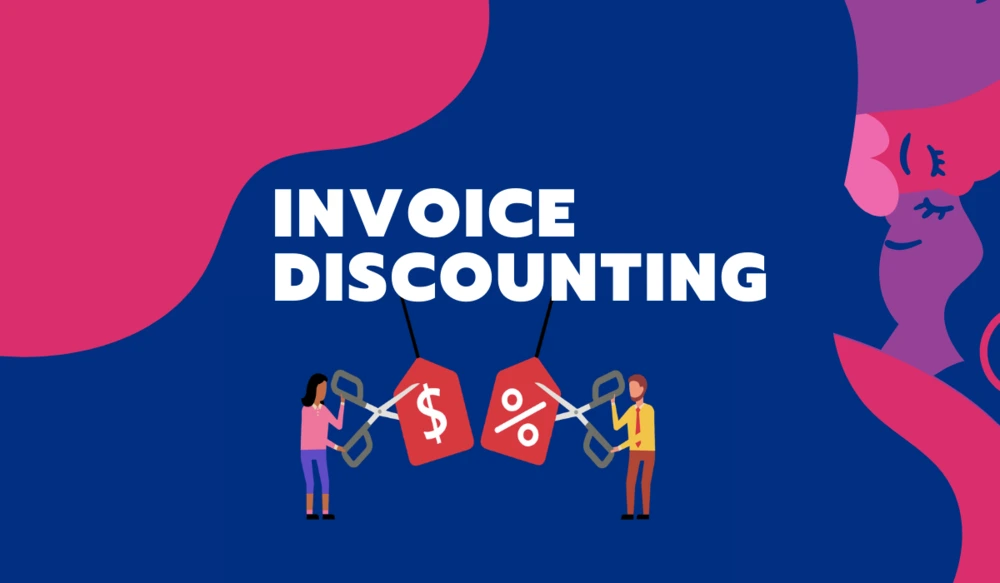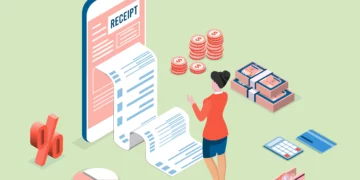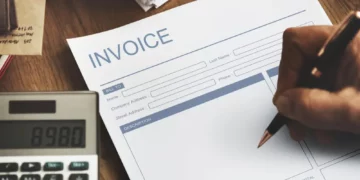Last Updated on November 28, 2025
Invoice discounting
Are you struggling to keep up with the cash flow of your company? Have you ever heard of invoice discounting? If not, let me give you a brief introduction.
Invoice discounting meaning
Invoice discounting is a type of financing in which a business sells its unpaid invoices to a third-party financier, such as a bank or a factoring company, at a discounted rate.
The business receives an immediate payment for the invoice from the financier, and the financier collects the full amount from the customer when the invoice is due. In other words, the business is essentially borrowing money against its unpaid invoices, using them as collateral.
Understanding invoice discounting
Invoice discounting is a popular form of financing that allows businesses to access cash quickly by selling their unpaid invoices to a third-party financier. Let’s take a closer look at invoice discounting when to use it, and the parties involved in the process.
What is invoice discounting?
Invoice discounting is a type of financing where a business sells its unpaid invoices to a third-party financier, such as a bank or a factoring company, at a discounted rate. The business receives an immediate payment for the invoice from the financier, and the financier collects the full payment from the customer when the invoice is due.
When to use invoice discounting?
Businesses can use invoice discounting to improve their cash flow. For example, let’s say you run a small business that provides services to a large client. You invoice the client for $10,000, with payment due in 60 days.
However, you need cash now to pay your bills and employees. By using invoice discounting, you can sell your invoice to a third-party financier for ₹9,000. When the invoice is due, the financier will collect the full ₹10,000 from the client, but you’ll have ₹9,000 in cash immediately.
Also, Read: What is a Tax Invoice?
The parties involved in invoice discounting
There are typically three parties involved in invoice discounting: the business (also known as the seller), the customer (also known as the debtor), and the financier (also known as the factor).
The business sells its unpaid invoices to the financier, who provides cash upfront. The customer then pays the full invoice directly to the financier when it’s due.
In summary, invoice discounting is a great option for businesses that need to access cash quickly and improve their cash flow. By selling their unpaid invoices to a third-party financier, businesses can receive immediate payment and focus on growing their business.
Finding a reputable financier that can provide you with the best terms and rates for your business is important.
Importance of invoice discounting for businesses
Invoice discounting is becoming increasingly popular for businesses of all sizes. Here are a few reasons.
1. Improved Cash Flow: By selling their unpaid invoices to a third party, businesses can receive immediate payment and improve their cash flow. It can help them pay their bills on time, invest in new projects, and grow their business.
2. Flexibility: Invoice discounting can be a more flexible option than traditional bank loans. Businesses can choose which invoices to sell and how often depending on their needs.
3. Less Risk: Unlike traditional bank loans, invoice discounting does not require businesses to put up collateral. It means they are not at risk of losing their assets if they cannot repay the loan.
4. Time-saving: Managing accounts receivable and chasing down unpaid invoices can be time-consuming. Outsourcing this task to a third party allows businesses to save time and focus on other important aspects of their business.
Overall, invoice discounting can be an excellent option for businesses that need to improve their cash flow and manage their accounts receivable more efficiently. It’s important to research and find a reputable financier that can provide you with the best terms and rates for your business.
Quick Read: Types of Invoices
How invoice discounting works
a) A step-by-step explanation of the invoice discounting process
Here’s a step-by-step explanation of the invoice discounting process using an example of a manufacturing company based in India:
- Step 1
The manufacturing company sells goods to its customers and issues an invoice with payment terms. For example, the company sells INR 50,00,000 worth of goods to a customer with payment due in 60 days.
- Step 2
The manufacturing company uses invoice discounting to improve its cash flow. The company wants immediate cash instead of waiting for the customer to pay after 60 days.
- Step 3
The manufacturing company submits the invoice to a third-party financier. The company sends the invoice to the financier and any supporting documentation that the financier requires.
- Step 4
The financier verifies the invoice and conducts due diligence. The financier checks the customer’s creditworthiness and verifies that the invoice is legitimate.
- Step 5
The financier provides a cash advance to the manufacturing company. Once the financier is satisfied that everything is in order, it provides a cash advance to the manufacturing company, usually around 80% of the invoice value. In this case, the financier provides a cash advance of INR 40,00,000 (80% of INR 50,00,000).
- Step 6
The customer pays the invoice. When the invoice becomes due, the customer pays the full amount directly to the financier.
- Step 7
The financier deducts its fees and provides the remaining amount to the manufacturing company. The financier deducts its fees for the cash advance and then provides the remaining amount to the manufacturing company. Let’s assume that the financier charges a fee of 2%. When the customer pays the invoice, the full amount of INR 50,00,000 goes to the financier. The financier deducts its fee of INR 1,00,000 (2% of INR 50,00,000) and provides the remaining INR 39,00,000 to the manufacturing company.
By using invoice discounting, the manufacturing company received INR 39,00,000 immediately instead of waiting 60 days to receive the full amount from the customer. This has improved the company’s cash flow and allowed it to invest in other business areas.
Related Read: Difference Between Invoice and Bill
b) Eligibility criteria for businesses to apply for invoice discounting in India
The eligibility criteria for applying for invoice discounting in India may vary depending on the lender or financier. However, some common requirements must be met to be eligible for invoice discounting:
- The business must be registered and operating in India.
- The business must have a minimum turnover or revenue, which may vary depending on the lender.
- The business must have a history of invoicing customers and generating accounts receivables.
- The business must have creditworthy customers who are likely to pay their invoices on time.
- The business must have a good credit history and financial standing.
- The business may need to provide audited financial statements or other documentation to demonstrate its financial position.
- The business may need to provide information about the invoices it wants to discount, including the customer name, invoice amount, and payment terms.
Businesses need to research and shop to find a lender or financier offering invoice discounting with eligibility criteria that fit their specific needs. By meeting the eligibility criteria and working with a reputable lender or financier, businesses can access the benefits of invoice discounting and improve their cash flow.
Quick Read: How To Avoid Invoice Discrepancies?
c) The role of a lender in the invoice discounting process
The role of the lender in the invoice discounting process is to provide cash advances to businesses against their outstanding invoices. The lender, or financier, buys the invoices from the business at a discounted rate and provides an immediate cash advance, usually around 80% of the invoice value.
The lender then collects the full invoice amount from the customer when it becomes due and deducts its fees before returning the remaining balance to the business.
Here are some specific roles of a lender in the invoice discounting process:
- Verifying the invoices: The lender verifies the invoices submitted by the business to ensure that they are genuine and meet the lender’s eligibility criteria.
- Conducting due diligence: The lender conducts due diligence on the business and its customers to assess their creditworthiness and ability to pay.
- Providing cash advances: Once the invoices are verified and due diligence is complete, the lender provides a cash advance to the business against the outstanding invoices.
- Collecting payments: The lender collects the full invoice amount from the customer when it becomes due.
- Deducting fees: The lender deducts its fees for providing the cash advance and managing the invoice collection process.
- Returning the balance: After deducting its fees, the lender returns the remaining balance to the business.
Overall, the lender plays a crucial role in providing cash flow to businesses by offering invoice discounting services. By working with a reputable lender, businesses can access the benefits of invoice discounting and improve their cash flow without waiting for their customers to pay their outstanding invoices.
Suggested Read: How To Do Invoice Processing?
d) How much financing can be obtained through invoice discounting
The amount of financing that can be obtained through invoice discounting in India depends on various factors such as the lender’s policies, the creditworthiness of the business and its customers, the size and volume of the invoices, and the repayment terms.
Generally, businesses can receive a cash advance of around 70% to 90% of the invoice value through invoice discounting.
For example, let’s say a manufacturing company in India has outstanding invoices worth Rs. 1,00,000 from a creditworthy customer. The lender offers an invoice discounting facility with an advance rate of 80%.
The company can then receive a cash advance of Rs. 80,000 (80% of Rs. 1,00,000) from the lender. Once the customer pays the invoice in full, the lender collects the full amount and deducts its fees before returning the remaining balance to the company.
It’s important to note that the fees charged by the lender for invoice discounting can vary and can include interest charges, processing fees, and other charges. Therefore, businesses should carefully review the lender’s terms and conditions before deciding to use invoice discounting as a financing option.
By using invoice discounting wisely and with a reputable lender, businesses can improve their cash flow and access the funding they need to grow and expand their operations.
Recommended Read: Commercial Invoice Meaning
Invoice discounting example
Let’s say there is an Indian organization that deals in microchips called “Microchip Solutions Pvt. Ltd.” They have recently delivered a consignment of microchips worth Rs. 15 lakhs to a large electronic goods manufacturing company.
The payment terms are 60 days from the date of delivery, and Microchip Solutions Pvt. Ltd. needs immediate cash to pay its suppliers and meet its operational expenses.
In this scenario, the company can opt for invoice discounting to improve its cash flow. They approach a lender or financier that offers invoice discounting services and submits the invoice for the consignment of microchips worth Rs. 15 lakhs.
The lender conducts due diligence on the invoice and the electronic goods manufacturing company to assess their creditworthiness.
Once the lender approves the invoice, they offer an advance of 80% of the invoice value, which is Rs. 12 lakhs (80% of Rs. 15 lakhs). Microchip Solutions Pvt. Ltd. receives the cash advance immediately, which they can use to pay their suppliers and meet operational expenses. The lender then collects the full invoice amount from the electronic goods manufacturing company when it becomes due after 60 days.
The lender deducts its fees, which could be around 1% to 3% of the invoice value, before returning the remaining balance of Rs. 2.55 lakhs to Microchip Solutions Pvt. Ltd. The fees may vary depending on the lender’s policies and the creditworthiness of the parties involved.
In this way, Microchip Solutions Pvt. Ltd. can access immediate cash flow by using invoice discounting and avoid the cash flow gap that often occurs due to delayed customer payments. They can use the cash advance to grow their business, pay their suppliers on time, and invest in new projects.
Suggested Read: Invoice Management: The Definitive Guide
How to implement invoice discounting in your organization
1. Invoice discounting process
To implement invoice discounting, you will first need to find a lender or a financier who offers this service. Once you have identified a suitable lender, you can submit your outstanding invoices to them for evaluation. The lender will assess the creditworthiness of your customers and the invoices to determine the amount of cash advance they can offer you.
If the lender approves your invoices, they will offer you a cash advance, typically around 70% to 90% of the invoice value. You can use this cash advance to pay your suppliers, meet your operational expenses, and invest in new projects. When your customers pay the invoice, the lender will collect the full amount and deduct their fees before returning the balance to you.
2. Documents required for invoice discounting
To implement invoice discounting, you must provide certain documents to the lender. These documents typically include:

Invoices: You must provide copies of the invoices you want to discount. These invoices should be genuine, and you should have fulfilled the goods or services mentioned in the invoice.
- Proof of delivery: You may need to provide proof of delivery of the goods or services mentioned in the invoice. This can be in the form of a signed delivery receipt or any other document showing the goods or services were rendered.
- Purchase orders: You may need to provide copies of the purchase orders you received from your customers. This will help the lender to evaluate the creditworthiness of your customers.
- Financial statements: You may need to provide your financial statements, such as balance sheets, profit and loss statements, and cash flow statements. These statements will help the lender to assess your financial health and creditworthiness.
- Other documents: Depending on the lender’s policies, you may need to provide other documents such as bank statements, tax returns, and business licenses.
By providing these documents, you can help the lender to evaluate your creditworthiness and the creditworthiness of your customers. This will increase your chances of getting approval for invoice discounting and improve your cash flow.
Also, Read: What is a Proforma Invoice?
Invoice discounting costs and fees in India
When you opt for invoice discounting in India, you should be aware of the costs and fees associated with this financing option. The costs and fees can vary depending on the lender and the terms of the agreement, so it’s important to do your research and compare the offers of different lenders.
Typically, invoice discounting involves the following costs and fees.
1. Interest rate: The lender will charge you an interest rate on the cash advance they provide you. The interest rate can vary depending on various factors, such as the creditworthiness of your customers, the risk involved, and the financing duration.
2. Processing fee: The lender may charge you a processing fee for evaluating your invoices and processing the cash advance. This fee can range from 0.5% to 3% of the invoice value.
3. Service fee: The lender may also charge you a service fee for managing the invoice collection process and handling administrative tasks. This fee can range from 0.5% to 2% of the invoice value.
4. Penalty fee: If your customer fails to pay the invoice on time, the lender may charge you a penalty fee. This fee can range from 1% to 3% of the outstanding invoice amount.
It’s important to note that some lenders may also require you to maintain a minimum invoice volume or a minimum turnover to be eligible for invoice discounting. You should also be aware of any hidden costs or fees the lender may not disclose upfront.
By understanding the costs and fees involved in invoice discounting in India, you can make an informed decision and choose a lender with the most favorable terms and conditions.
Quick Read: What is Invoice Financing?
Features and Benefits of invoice discounting
Invoice discounting is a financing option that allows businesses to improve their cash flow by obtaining quick access to cash tied up in unpaid invoices. It is a flexible and efficient financing option with various features that benefit businesses. Let’s look at some of the key features of invoice discounting:
- Quick access to cash: Invoice discounting allows businesses to access cash quickly and easily, typically within a few days of submitting an invoice.
- Improved cash flow: By receiving cash upfront for unpaid invoices, businesses can improve their cash flow and meet their financial obligations on time.
- No collateral required: Invoice discounting is an unsecured financing option that does not require businesses to provide any collateral or assets as security.
- Flexible financing: Invoice discounting offers flexible financing that you can customize to meet the specific needs of your business. Businesses can choose which invoices to discount and how much cash to receive.
- Confidentiality: Invoice discounting can be arranged on a confidential basis, which means that your customers may not be aware that you are using this financing option.
- Credit control: The lender may provide credit control services to help businesses manage their receivables and reduce the risk of bad debts.
- Cost-effective: Invoice discounting can be a cost-effective financing option compared to other types of financing, as the costs and fees involved are usually lower.
- Scalability: Invoice discounting can be scaled up or down based on the business’s requirements, making it a suitable financing option for businesses of all sizes.
Overall, invoice discounting offers businesses a convenient, flexible, and cost-effective way to improve their cash flow and manage their receivables. By understanding the key features of invoice discounting, businesses can determine whether this financing option is right for them and choose a lender that offers them the best terms and conditions.
Also, Read: Purchase Order vs Invoice
Advantages of invoice discounting
Due to its numerous advantages, invoice discounting is a popular financing option for almost all companies in India. Let’s take a look at some of the advantages for such companies.
1. Improved cash flow
Invoice discounting allows companies to access cash quickly and easily, improving their cash flow and helping them meet their financial obligations on time.
For example, a mid-size manufacturing company in India can use invoice discounting to obtain cash upfront for unpaid invoices, which can help them pay their suppliers and meet other expenses.
2. No collateral required
Invoice discounting is an unsecured financing option that does not require companies to provide any collateral or assets as security. This makes it a convenient and hassle-free financing option for companies with insufficient assets to provide as collateral.
For example, a large IT services company in India can use invoice discounting to obtain cash without pledging assets.
3. Cost-effective
Invoice discounting can be a cost-effective financing option compared to other types of financing, as the costs and fees involved are usually lower.
For example, a mid-size healthcare company in India can use invoice discounting to obtain cash at a lower interest rate than a bank loan.
4. Confidentiality
Invoice discounting can be arranged on a confidential basis, which means that the customer may not be aware that the company is using this financing option. This can help companies maintain a positive relationship with their customers and avoid any negative impact on their business.
For example, a large FMCG company in India can use invoice discounting to obtain cash without disclosing it to their customers.
5. Credit control
The lender may provide credit control services to help companies manage their receivables and reduce the risk of bad debts.
For example, a mid-size logistics company in India can use invoice discounting to obtain cash and also benefit from the lender’s credit control services to manage their receivables.
Overall, invoice discounting can provide numerous benefits to mid-size and large companies in India, including improved cash flow, lower costs, no collateral requirements, confidentiality, and credit control services. These advantages make invoice discounting a popular financing option for companies looking to improve their financial position and manage their cash flow efficiently.
Also, Read: What is Financial Modelling?
Disadvantages of invoice discounting
While invoice discounting can offer several benefits to organizations, there are also some potential disadvantages. Here are some of the major disadvantages.
1. High interest rates
The interest rates on invoice discounting can be higher than other types of financing, especially if the organization has a poor credit history. For example, a mid-size construction company in India may have to pay a higher interest rate on invoice discounting if they have a history of defaulting on loans.
2. Potential loss of control
When using invoice discounting, the lender may require the organization to relinquish control over their accounts receivable. This can reduce the organization’s control over its cash flow and customer relationships.
For example, a large textile company in India may lose control over its accounts receivable if they use invoice discounting and the lender takes over their credit control.
3. Impact on customer relationships
Invoice discounting can potentially damage customer relationships if the customers become aware of the organization’s use of the financing method. For example, a mid-size pharmaceutical company in India may lose the trust of its customers if they find out that the company is using invoice discounting to manage its cash flow.
4. Eligibility requirements
Organizations may not be eligible for invoice discounting if they have a limited number of customers or if their invoices have long payment terms. For example, a small e-commerce business in India may not be eligible for invoice discounting if their invoices have a 60-day payment term.
5. Hidden costs and fees
While the costs and fees associated with invoice discounting may be lower than other types of financing, there may be hidden costs that organizations are not aware of. For example, a large retail company in India may incur additional fees for early repayment of the invoice discounting facility.
Organizations need to weigh the potential advantages and disadvantages of invoice discounting before deciding to use this financing method. While it can offer improved cash flow and lower costs, organizations should also consider the potential risks and drawbacks before making a decision.
Related Read: Budgeting and Forecasting: A Comprehensive Guide
Difference between invoice discounting and invoice factoring
Overall, invoice discounting and factoring offer financing solutions for businesses needing cash flow. Invoice discounting may be more suitable for businesses that wish to retain control over their accounts receivable, have a strong credit history, and require lower costs and fees.
Factoring may be more suitable for businesses with weaker credit histories, require immediate cash flow, or wish to offload the responsibility of collecting customer payments.
Suggested reading: Invoice Vs Receipt: Importance, Differences, and Components
Here’s a comparative table for invoice discounting vs factoring
Criteria |
Invoice Discounting |
Factoring |
Definition |
A financing method where a business borrows money against their accounts receivable |
A financing method where a business sells its accounts receivable to a third party (factor) at a discount |
Control over AR |
Business retains control over accounts receivable |
Factor assumes control over accounts receivable |
Credit check |
Lender performs a credit check on the business only |
Factor performs credit checks on both the business and its customers |
Cost |
Lower costs and fees compared to factoring |
Higher costs and fees compared to invoice discounting |
Payment collection |
Business remains responsible for collecting payments from customers |
Factor is responsible for collecting payments from customers |
Relationship with customers |
Business maintains its relationship with customers |
Factor takes over the relationship with customers |
Availability |
Available to businesses with a strong credit history |
Available to businesses with weaker credit history or those in need of immediate cash flow |
Financing amount |
Financing amount is typically based on a percentage of the value of the accounts receivable |
Financing amount is typically higher compared to invoice discounting as the factor buys the accounts receivable at a discount |
Top invoice discounting platforms in India
Here are some of the top invoice discounting platforms in India:
1. KredX: KredX is one of the largest invoice discounting platforms in India, offering a digital platform to help businesses access working capital by discounting their unpaid invoices. It connects businesses with a network of investors who provide financing against their receivables.
2. Invoicemart: Invoicemart is an online invoice discounting platform that enables businesses to upload their unpaid invoices and receive funding within a few days. The platform is operated by A.TREDS Limited, a joint venture between Axis Bank and mjunction services limited.
3. M1xchange: M1xchange is a digital invoice discounting platform that connects businesses with financiers to enable them to access working capital by discounting their unpaid invoices. It is operated by Mynd Solutions, a business process management firm.
4. OfBusiness: OfBusiness is a technology-driven platform that offers invoice discounting services to small and medium enterprises (SMEs) in India. It connects SMEs with a network of lenders who provide financing against their receivables.
5. Axio (previously called Capital Float): Axio is an online lending platform that offers invoice discounting services to businesses in India. It enables businesses to access working capital by discounting their unpaid invoices and provides financing within 48-72 hours.
All of these platforms offer businesses a simple and efficient way to access working capital by discounting their unpaid invoices. They provide a range of features and benefits, including competitive pricing, fast funding, and online access to financing.
Businesses can choose the platform that best suits their needs based on factors such as pricing, financing amount, and eligibility criteria.
Also, Read: 12 Best Invoicing Software for Your Business
Conclusion
In conclusion, invoice discounting is a viable financing option for businesses of all sizes, especially for those dealing with long payment terms. It offers numerous advantages such as improved cash flow, better control over finances, and lower interest rates compared to traditional loans.
However, it also has some drawbacks such as higher costs and the risk of customer relationships being affected. Despite this, with the advent of technology, invoice discounting has become more accessible and easier to use.
With the right platform and careful consideration of the pros and cons, businesses can effectively manage their working capital needs and achieve their financial goals.
FAQs
Invoice discounting can be a good idea for businesses looking to improve their cash flow and access working capital quickly. It offers advantages such as lower interest rates, increased flexibility, and better control over finances. However, it is important to carefully consider the costs and risks associated with invoice discounting, including potential strain on customer relationships and the possibility of hidden fees. Overall, invoice discounting can be a good financing option if used properly and with a thorough understanding of its advantages and disadvantages.
Invoice discounting involves some level of risk for businesses, as it involves financing against unpaid invoices. The main risks include the possibility of non-payment by customers, which could result in financial losses for the business.
There is also the risk of customer relationships being affected if they become aware of the financing arrangement. Additionally, there may be hidden fees or costs associated with invoice discounting that businesses should be aware of.
However, if managed properly and with a thorough understanding of the risks involved, invoice discounting can be a useful and relatively low-risk financing option for businesses.
An example of invoice discounting is a manufacturing company selling goods to a buyer on credit, and then using the unpaid invoice as collateral to obtain financing from a lender before the payment is due. This allows the business to access working capital quickly and improve cash flow.
Invoice discounting in India is a financing option that allows businesses to access working capital quickly by selling their unpaid invoices to lenders at a discount. This helps improve cash flow and provides greater financial flexibility for businesses.
a) Small and medium-sized enterprises (SMEs)
b) Large corporations
c) Businesses with long payment terms
d) Those experiencing cash flow issues
e) Companies looking for quick access to working capital
f) Organizations with a high volume of receivables
g) Businesses in industries with high overhead costs
h) Companies seeking greater financial flexibility
i) Those looking to manage their finances more efficiently.
Yes, invoice discounting is legal in India. The Reserve Bank of India (RBI) has issued guidelines for invoice discounting and the practice is recognized under the Factoring Regulation Act, 2011. The act provides a legal framework for invoice discounting and factoring transactions in India. Many financial institutions, banks, and NBFCs (Non-Banking Financial Companies) in India offer invoice discounting services to businesses.
In India, invoice discounting works in a similar way to other countries. Here are the basic steps of how it works:
1. A business sells goods or services to a buyer on credit and generates an invoice with payment terms.
2. The business then applies for invoice discounting from a lender, which involves submitting the unpaid invoice as collateral.
3. The lender evaluates the creditworthiness of the buyer and the business, and, if approved, offers financing against the invoice at a discounted rate.
4. The lender transfers the agreed amount to the business’s account, usually within a few days.
5. When the invoice payment is due, the buyer pays the lender directly.
6. The lender deducts their fees and returns the remaining amount to the business.
Overall, invoice discounting in India is a way for businesses to access working capital quickly by monetizing their unpaid invoices. It helps improve cash flow and provides greater financial flexibility for businesses.
In India, invoice discounting is open to all types of businesses, including small and medium-sized enterprises (SMEs) and large corporations, as long as they have unpaid invoices from creditworthy buyers. However, businesses must meet certain eligibility criteria set by the lender, such as a minimum annual turnover, minimum credit score, and minimum invoice value. Additionally, businesses must have a good track record of timely invoice payments and creditworthiness to qualify for invoice discounting in India.










Discussion about this post